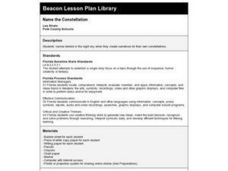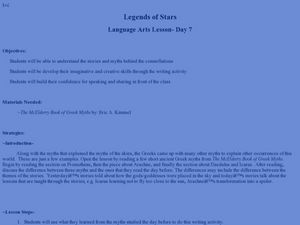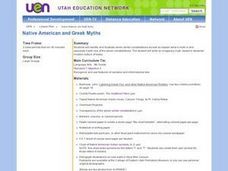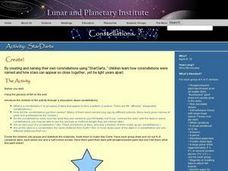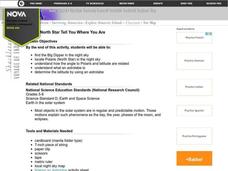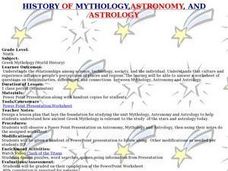Curated OER
Illustrate the Constellations
Students research ancient Greek heroes immortalized in constellations. They choose three constellations in either the summer or winter sky to illustrate and reinforce their understanding of the northern constellations.
Curated OER
Mapping Constellations
Students become familiar with constellations. In this space science lesson, the teacher introduces constellations by showing students the star patterns and reading myths. Students, observe the stars nightly, then choose one constellation...
Curated OER
Name the Constellation
Students read stories about constellations. They create constellations by filling in the letters of their names on a test bubble sheet and tracing the design onto white paper. They make up stories about their name constellations.
Curated OER
Illustrate the Constellations
Students explore space science by participating in a star identification activity. In this astronomy lesson plan, students identify different star patterns and discuss the movement of stars across the sky as the seasons change. Students...
Curated OER
Star Stories
An unusually inventive and entertaining presentation awaits you and your class. The first few slides introduce the animals that certain constellations represent. There are also creative stories by other students of fictitious animals...
Curated OER
Legends of Stars
After choosing a figure from Greek mythology, middle schoolers design, draw, and color a constellation to represent that person. Additionally, they create a story to tell how the constellation came to be. This lesson is a great addition...
Curated OER
Native American and Greek Myths
Fifth graders identify seven different constellations and explain a myth that accompanies it. As a class, they listen to myths associated with the Greek and Native American cultures. To end the activity, they write their own myth...
Curated OER
Greek Mythology
Ninth graders examine the characteristics of Greek Mythology. For this World History lesson, 9th graders study the connections between Greek Mythology and the Universe.
Curated OER
Constellations
In this constellations learning exercise, students read about the different constellations and how to locate them in the night sky. Then students complete 4 multiple choice and 7 short answer questions.
Curated OER
Greek Heroines Crossword
In this Greek heroines learning exercise, students fill in a crossword dealing with clues of Greek mythology. Students fill in 19 clues to the crossword.
American Museum of Natural History
What is Astronomy?
Go study the universe. Pupils learn seven aspects about astronomy and astronomers. They begin to learn about constellations; distance and motion between objects; gravity; the electromagnetic spectrum; dark matter and energy; and teams of...
Curated OER
Stars and Galaxies
Eighth graders define constellations and how they are used as reference points and identify stars and constellations in the nighttime sky. They construct their own planetarium star finder and identify the location of circumpolar, zodiac,...
Curated OER
"No News Like Ancient News"
Want to know more about Ancient history? Young historians will read a minimum of two web sites to complete the chart "Residents of Olympus". They choose one Greek god or goddess to research. This could be a small group activity or...
Curated OER
GREEK MYTHOLOGY, LEGENDS AND HEROES
Eighth graders examine the effect of background and culture by creating a family tree and "mythical" story or legend based on Delmas Howe's painting Atlas.
Curated OER
StarDarts
Students divide into groups of four or five and distribute materials to design StarDarts by drawing and cutting out 6-8 cardstock stars, each about one and a half inches across. They decorate their stars with phosphorescent paint...
Curated OER
Finding the Pole Star
Students study the constellations fo the Big Dipper and Cassiopeia and their use in finding the Pole Star. They realize that other celestial objects--Sun, Moon and planets--share the rotation (and hence rise and set), even though their...
Curated OER
Reach for the Stars
Fifth graders select Greek Mythological characters to research. They gather research and keep notes on Inspiration. Students are to answer the question, "Which mythological character do you feel is the most worthy of being a...
Curated OER
It's Written in the Stars!
Children create narrative accounts about their character traits, illustrate the constellation of each sign of the Zodiac, and write and illustrate their own creative myths about an original "Zodiac Sign". They use the computer as a...
Curated OER
Let the North Star Tell You Where You Are
Students participate in activities in which they find the Big Dipper and locate the North Star in the night sky, examine the relationship between the angle to Polaris and latitude, and determine latitude by using an astrolabe.
Curated OER
Sky Stories Curriculum
Students investigate the stories told by ancient cultures about the constellations. They listen to stories told by the Greeks and Romans. The classroom should have posters of constellations for the lesson and the teacher performs...
Curated OER
Linguistic Humor and Language Play
By George, there are so many literary devices illustrated here! Help your pupils create interest in their writing by presenting one or two of these literary devices at a time. The slides contain examples and beg participation from the...
Curated OER
The Wanderers: Planets of Our Solar System
In this planets worksheet, students read a detailed 3 page text about the planets in our solar system. Students then complete 21 true/false and multiple choice questions about planets.
Curated OER
Scavenger Hunt: Who am I?
In this solar system learning exercise, students use an on line source to find the names of the people who discovered the planets, comets, asteroids, black holes and the idea of the big bang theory.
Curated OER
History of Mythology, Astronomy and Astrology
Ninth graders examine the relationships of science and technology and how it influences people's perceptions of places. In this mythology and astronomy lesson students view a PowerPoint presentation and complete a worksheet.




